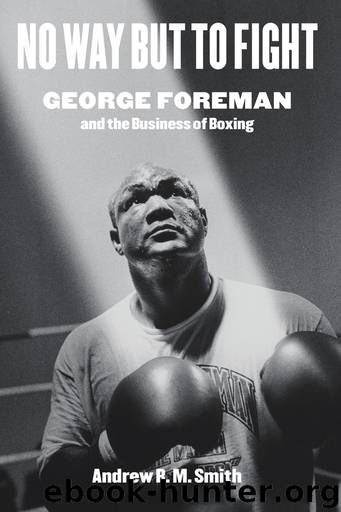No Way but to Fight by Andrew R.M. Smith

Author:Andrew R.M. Smith [Smith, Andrew R. M.]
Language: eng
Format: epub
Publisher: University of Texas Press
Published: 2019-05-04T16:00:00+00:00
12
You Got to Have a Boss
Staring up into a wet African sky, though, Foreman knew he’d have to get up.
JACK B. BEDELL, “George Foreman in Zaire,” Hudson Review 62, no. 2 (2009): 259
“In the idiom of Brooklyn,” Archie Moore said, “[Foreman] blew his cool.” The veritable professor of pugilism, who had a view from the corner of the ring, reduced the ex-champ’s fall to pithy slang. Foreman was not going to regain any coolness in Kinshasa. He got out of Zaire as fast as he could—without any of the impediments he faced in Venezuela—but he couldn’t go home yet. There were too many unanswered questions, and questions he did not want to answer at all. The Rumble in the Jungle left him searching, as the Louisiana poet Jack Bedell wrote, “for some succubus to blame.” The water in the dressing room, the ropes before the fight, the advice from his corner during the action, his team’s mixed signals after his knockdown, and the referee’s count all replayed over and over in his head. To explain his first professional defeat, Foreman thought about outside interests like gangsters and gamblers, and about an inside job by Sadler, Saddler, or Moore. “I felt as if my core had evaporated,” he recalled, so Hayward Moore whisked him away to rebuild it through weeks of intensive retail therapy. Over the next two years, Foreman crafted a new core, one more in line with that of a large percentage of Americans as he doggedly chased a chance to regain the heavyweight title.1
The process started in Paris, where Moore arranged for daily massages and brought food to Foreman’s hotel room so that he could heal physically as well as mentally. From there they flew to Los Angeles, but only to hop a plane bound for Hawaii. Alternately feeding the birds and feasting on macadamia pancakes aided his recovery. When Moore asked what Foreman needed before he could go home, he had an answer: a convertible Rolls-Royce. Again taking care of the details, Moore had a Chicago dealer send one to Houston, where they picked it up and drove back into reality—a lost title, a new paternity suit, and an identity crisis.2
It took time to resolve the paternity case with a short-term girlfriend from Pleasanton, Pamela Clay, but that delay paled in comparison with the quarter century it took for Foreman to realize that his old nickname Mo’head was more than a dig at his big cranium. It was a reference to his biological father, Leroy Moorehead. Confirming enough details with siblings and aunts, he eventually confronted his mother and heard the truth. Foreman arranged a meeting in Texarkana, not too far from the ranch that he had purchased in his birthplace, Marshall. Foreman’s and Moorehead’s relationship lasted only a few years, until Moorehead’s death in 1978, but the experience left an indelible impression on Foreman. When test results proved he was the father of Clay’s son, he insisted the baby take his full name: George Edward Foreman. If he had any more sons, he intended to do the same.
Download
This site does not store any files on its server. We only index and link to content provided by other sites. Please contact the content providers to delete copyright contents if any and email us, we'll remove relevant links or contents immediately.
The Housekeeper by Natalie Barelli(1483)
Mind to Matter by Dawson Church(1308)
The 2012 Story by John Major Jenkins(1048)
The White Spider by Heinrich Harrer(1008)
The Red Bandanna by Tom Rinaldi(994)
Dreamcatcher by Stephen King(964)
Tiger Woods by Jeff Benedict & Armen Keteyian(956)
The Blind Side: Evolution of a Game by Michael Lewis(890)
Interesting by Steve Davis(869)
American Colossus by Allen M. Hornblum(859)
The Wedge by Scott Carney(849)
Becoming Johnny Vegas by Johnny Vegas(848)
Play Poker Like the Pros by Phil & Jr. Jr. Hellmuth(816)
Guinness World Records 2014 by Guinness World Records(798)
When You Dead, You Dead by Guy Martin(793)
Nick Hornby(790)
Breaking the Surface by Greg Louganis & Eric Marcus(785)
Deadliest Men by Kirchner Paul(780)
Steinbrenner by Bill Madden(779)
